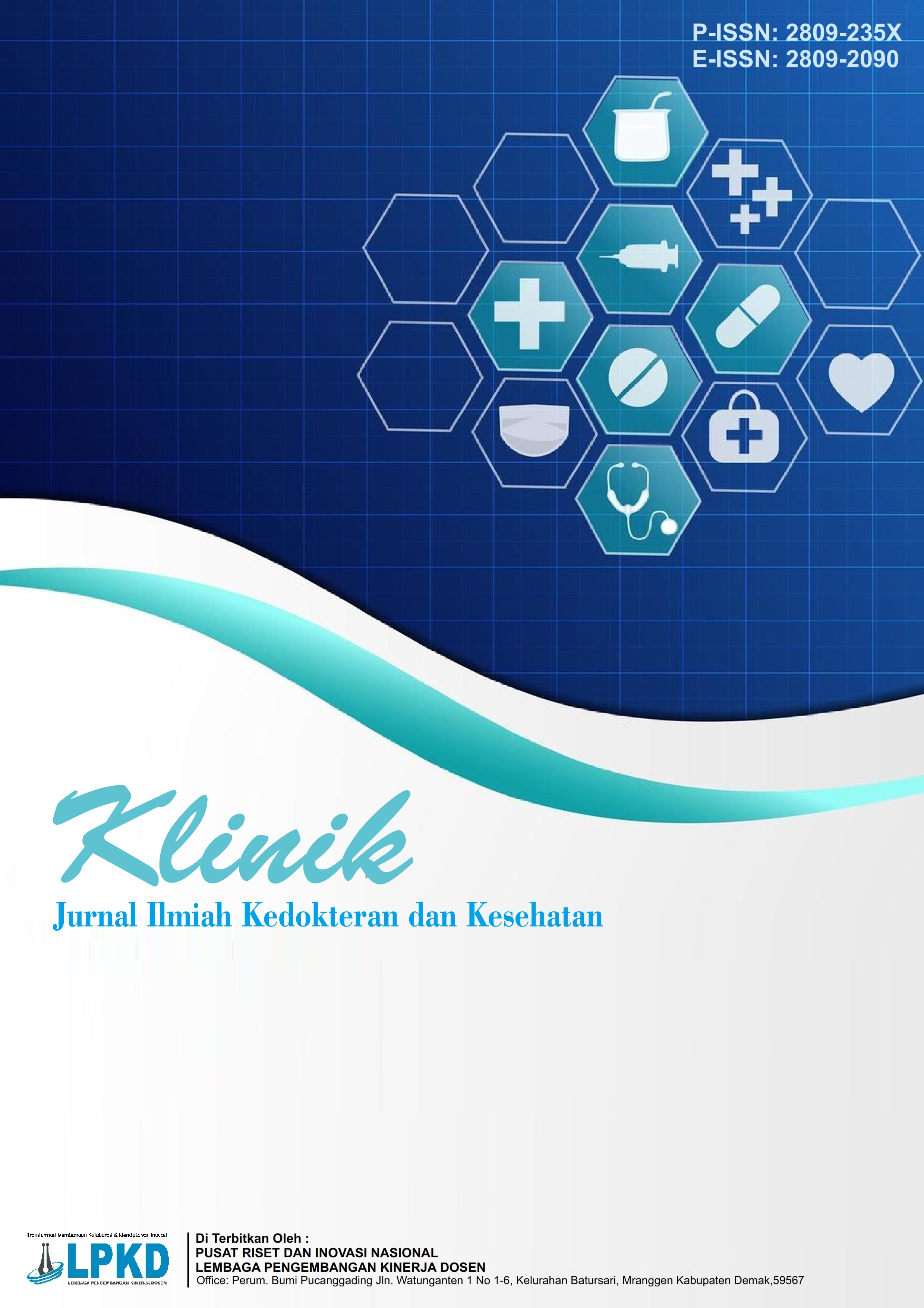Kontribusi Persepsi Keharmonisan Keluarga terhadap Problematic Internet Use pada Remaja
DOI:
https://doi.org/10.55606/klinik.v4i3.4493Keywords:
Adolescents, Family Harmony, Problematic Internet UseAbstract
The use of the internet has many benefits and also makes it easier for someone to do their work, besides the positive benefits, if it is used inappropriately it will trigger problems such as problematic internet use. Problematic internet use according to demetrovis et al (2008) is a condition where someone has difficulty controlling internet use. One of the factors causing problematic internet use is the family harmony. The purpose of this study was to analyze the contribution of perceptions of family harmony to problematic internet use in adolescents in West Sumatra with 400 respondents. This research uses a quantitative method study with cluster sampling technique. Problematic internet use and family harmony were measured using a measuring instrument compiled by researchers based on aspects of demetrovics et al (2008) for problematic internet use and kavikondala et al (2016) for family harmony. Based on the results of a analysis simple linear regression, an value of r square is 0.088 was obtained, indicating that family harmony contributed to problematic internet use in adolescents by 8.8%.
References
Agriyani, M. A., & Widyastuti, T. (2023). Adaptasi Skala Problematic Internet Use Questionnaire (PIUQ) Versi Indonesia. Psikodimensia: Kajian Ilmiah Psikologi, 22(2), 157-167.
Agusti, R. D. C. W., & Leonardi, T. (2015). Hubungan antara kesepian dengan problematic internet use pada mahasiswa. Jurnal Psikologi Klinis dan Kesehatan Mental, 4(1), 9-13.
Anisa, A. N., & Kaloeti, D. V. S. (2022). Hubungan Antara Keharmonisan Keluarga dan Moralitas Pada Siswa Kelas XI SMK Muhammadiyah 3 Weleri. Jurnal EMPATI, 11(4), 223-228.
Arintina, Y. C., & Fauziah, N. (2015). Keharmonisan keluarga dan kecenderungan berperilaku agresif pada siswa SMK. Jurnal Empati, 4(1), 208-212.
Arum, L. S., Zahrani, A., & Duha, N. A. (2023). Karakteristik Generasi Z dan Kesiapannya dalam Menghadapi Bonus Demografi 2030. Accounting Student Research Journal, 2(1), 59-72.
Caplan, S. (2019). Generalized Problematic Internet Use Scale (GPIUS). Researchgate, 2(December), 10–11. https://doi.org/10.13140/RG.2.2.18923.08483
Caplan, S., Williams, D., & Yee, N. (2009). Problematic Internet use and psychosocial well-being among MMO players. Computers in human behavior, 25(6), 1312-1319. https://doi.org/10.1016/j.chb.2009.06.006
Darwin, M., Mamondol, M.R., Sormin, S.A., Nurhayati, Y., Tambunan, H., Sylvia, D., Adnyana, I.M.D.M., Prasetiyo, B., Vianitati, P. and Gebang, A.A., (2021). Metode penelitian pendekatan kuantitatif. Media Sains Indonesia.
Data Kependudukan - KEMENDAGRI: https://gis.dukcapil.kemendagri.go.id/peta
Demetrovics, Z., Szeredi, B., & Rózsa, S. (2008). The three-factor model of Internet addiction: The development of the Problematic Internet Use Questionnaire. Behavior research methods, 40, 563-574.
Garvin, G. (2019). Hubungan antara kesepian dengan problematic internet use pada remaja. Psikostudia: Jurnal Psikologi, 8(1), 15-19.
Kavikondala, S., Stewart, S. M., Ni, M. Y., Chan, B. H., Lee, P. H., Li, K. K., & Leung, G. M. (2016). Structure and validity of Family Harmony Scale: An instrument for measuring harmony. Psychological assessment, 28(3), 307.
Kemendagri.go.id. (2024). dukcapil.kemendagri.go.id/peta. From Visualisasi
Kemp, S. (2022) Digital 2022 Indonesia. Retrieved October 07, 2024 from https://datareportal.com/reports/digital-2022-indonesia
Liu, C., Wang, X., Zhang, X., Liu, Y., Lin, R., Wu, Y., & Wang, D. (2024). The impact of family climate on problematic internet use: Findings from one nationwide study in China. Journal of Affective Disorders, 367, 350-358.
López de Ayala López, M. C., Sendin Gutierrez, J. C., & Garcia Jimenez, A. (2015). Problematic Internet use among Spanish adolescents: The predictive role of Internet preference and family relationships. European Journal of Communication, 30(4), 470-485.
Oktarizal, R., Zaini, A,. Chandra, T. (2022). Students' Perceptions About Family Harmony (Study of Adolescents from Low-Economy Families at SMKN 3 Padang). Jurnal Riset Ilmu Pendidikan, 2(3), 172-176.
Putra, Y. S. (2016). Theoritical review: Teori perbedaan generasi. Among makarti, 9(2).
Sahir, S. H. (2022). Metodologi Penelitian. Jogjakarta: Penerbit KBM Indonesia.
Saquib, N., Saquib, J., AlSalhi, A., Colder Carras, M., Labrique, A. B., Al-Khani, A. M., ... & Almazrou, A. (2023). The associations between family characteristics and problematic Internet use among adolescents in Saudi Arabia. International Journal of Adolescence and Youth, 28(1), 2256826.
Sugiyono. (2020). Metode Penelitian Kuantiatif, Kualitatif, dan R & D. Bandung: Alfabeta.
Saragih, E. S. (2020). Kontrol Diri dan Kecenderungan Internet Addiction Disorder. Philanthropy: Journal of Psychology, 4(1), 57.
Septianti, L., & Aulia, F. (2024). Hubungan Self Control Dengan Problematic Internet Use Pada Mahasiswa. Nusantara: Jurnal Ilmu Pengetahuan Sosial, 11(1), 155-159.
Shapira, N. A., Goldsmith, T. D., Keck, P. E., Khosla, U. M., & McElory, S. L. (2000). Psychiatric features of individuals with problematic internet use. Journal of Affective Disorders 57, 267–272.
Sulastri, D., Rasimin, R., & Yusra, A. (2025). Pengaruh Kepercayaan Diri Terhadap Kemampuan Public Speaking siswa di SMA N 1 Muaro Jambi. Jurnal Mahasiswa BK An-Nur: Berbeda, Bermakna, Mulia, 10(3), 98-105.
Yudhistira, S., Wahyuni, L. D. ., & Deasyanti, D. (2022). Literasi Digital pada Mahasiswa: Dampak Keberfungsian Keluarga dalam Mengatasi Penyalahgunaan Internet di Masa Pandemi. MAARIF, 17(1), 112–127. https://doi.org/10.47651/mrf.v17i1.165
Downloads
Published
How to Cite
Issue
Section
License
Copyright (c) 2025 Jurnal Ilmiah Kedokteran dan Kesehatan

This work is licensed under a Creative Commons Attribution-ShareAlike 4.0 International License.








